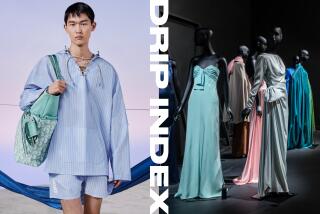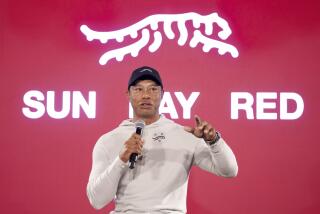Surf ‘n’ Turf
Showing a Midas touch for marketing, apparel designer Tommy Hilfiger in 1994 outfitted Snoop Doggy Dogg for a “Saturday Night Live” appearance and became an instant hit with rappers.
Call it cool by association.
Now, the traditional clothier is trying to show surfers that his beachwear is “authentic” by wielding another unlikely marketing tool: the Paskowitz family, a clan that once lived in a van in search of the perfect wave.
Considered the epitome of the off-center, laid-back surf culture, the Paskowitzes may be, as one insider put it, “the most legitimate surf family in California.”
And since it helps to find an inside track when breaking into a niche market, Hilfiger’s decision to sponsor the Paskowitz Summer Surf Camp at San Onofre State Beach may prove to be a shrewd move.
“The challenge for big brand companies like that is to stay connected to all the different niche groups,” said Pat Cochran, former editor of Surf Business and Action Sports Retailer magazines. “You can’t really get much more core than the Paskowitz family.”
The association with the Paskowitz clan of eight brothers and a sister “authenticizes the company’s surf line,” said Andy Hilfiger, a spokesman for his brother’s company. “They know all the right people, the players.”
In the world of surfing, authenticity is key and surfers tend to balk when someone without surfing roots paddles into the territory. In this upside-down universe, small is cool and nobody gets points for being famous.
“This consumer is not going to run to embrace Tommy Hilfiger,” said Dick Baker, chief executive of Ocean Pacific Apparel and former president of Tommy Hilfiger’s Womensware brand.
That could be putting it mildly if a recent sampling of surfers at San Onofre State Beach means anything. They generally nixed the prospect of “the red, white and blue guy,” as one of them called Hilfiger, selling surf wear.
“He shouldn’t even think about it. No way,” said Steve Butler, a 20-year-old San Juan Capistrano resident. “People know about Tommy Hilfiger. It’s, like, famous, and we don’t want people to know about surfing.”
“It’s kind of like Nike trying to sell surf wear, in a way,” said Donald Langford, 27, a Cal State Fullerton student. “It doesn’t fly.”
Some said Hilfiger clothing would probably be too expensive for their budgets but, either way, they wouldn’t buy it.
“It’s not my style,” said Jack Garrett, 27. “Not a lot of surfers go to Broadway and Nordstrom for clothes.”
Hilfiger officials say they don’t know yet if the company will attempt to sell its beachwear in surf shops, where skepticism about outsiders can be palpable.
“We know who’s real and who’s not,” said Aaron Pai, owner of Huntington Surf & Sport, one of the largest shops in Southern California. “I’ve seen a lot of imitators in this industry, and authenticity is everything.”
That’s where the Paskowitzes come in.
In exchange for the sponsorship, family members and surf camp employees will wear and distribute Hilfiger gear.
“Every one of the students will get a bag and a T-shirt from Tommy Hilfiger,” said Israel Paskowitz, 35, who manages the surf camp, which opened this month at San Onofre State Beach. “I’m wearing a pair of Tommy trunks right now.”
There are skeptics, however, even within the Paskowitz family.
On the beach at San Onofre recently, patriarch Dorian Paskowitz, 77, said he feels “privileged” that Hilfiger is sponsoring the camp, but scoffed at the design of his trunks.
“See how they’re made?” he said, pulling the netting from inside the swimwear. “No surfer would be caught dead in those trunks.”
Family spokesman Jonathan Paskowitz, 36, said the netting is just an example of the design details that Hilfiger is resolving. The next batch of trunks will be net-free, he said. Once such issues are ironed out, Hilfiger will give other surf-wear companies some serious competition, he said.
“Tommy is the peak of clothing manufacturing,” Jonathan Paskowitz said. “Once they get the design down, I think it’s going to be a cat fight. A real cat fight.”
Such pesky problems are common to companies that are trying to move into a niche market where buyers can be excruciatingly picky.
“It takes years to develop a good board short,” said professional surfer Chris Malloy, who has given design input to Billabong USA. “If [surfers] feel it’s a big company that isn’t involved and is just powering it out from a company in New York, they’re not going to touch the stuff.”
Actually, Hilfiger has been including board shorts and other surf apparel in its sportswear line each spring and summer for the last few years, Andy Hilfiger said. This year, the company took a new marketing tact, “bringing fashion to the beach.”
“We thought it would be a great idea to get involved with the Paskowitz surf camp because they have such a grass roots marketing thing happening,” he said. “It really makes it mean something to have all these surfers wearing it.”
The family has also been talking to Hilfiger about developing a few items--such as caps and T-shirts-that bear the Paskowitz “stamp of approval” and could therefore appeal to the “hard core” surf crowd, Jonathan Paskowitz said.
The two families met through mutual friends about six months ago and some of the Paskowitz clan attended a Hilfiger party in Las Vegas in February. In May, the Paskowitz brothers were feted by the Hilfigers when they attended an Esquire magazine party in Manhattan.
In what a Hilfiger spokeswoman called “a marvelous coincidence,” the Paskowitz and Hilfiger brothers are both featured in this month’s Esquire in a pictorial on brothers.
The Paskowitz family’s fame stems from a variety of sources, beginning with patriarch Dorian Paskowitz’s decision decades ago to raise his brood in a van. They roamed the globe, stopping when the surf was up.
To root his family, Paskowitz founded the surf camp, a place where they could settle for a season, and still keep surfing.
Today, the clan is viewed by many as the quintessential surf family.
Some people in the surf industry say that for Hilfiger’s surf wear to be taken seriously, the company will have to travel a rut worn by established surf wear businesses and sponsor professional surfers. This can help because some surfers buy what their surfing idols wear.
But sponsoring a high-profile surf family may be smarter, said Cochran, the former magazine editor.
Professional surfers’ names “are just not big enough to mean much to mainstream America,” she said. “I think everybody can relate to a cool family that surfs. It’s a much easier point of entry if you’re trying to make a connection.”
Despite fierce competition, some say Hilfiger could stage a bloodless coup. With sales of $660 million last year, the Manhattan-based company has the money and marketing expertise as well as a track record that proves it can wheedle into niche markets.
Last year, Hilfiger challenged big-name companies such as Nike and Adidas by launching TH Athletics, a line of sportswear mini-stores that Hilfiger said is growing at a healthy pace.
But two other sportswear giants--Nike and Guess--stumbled badly when they tried to break into the hallowed waters of surfing.
With the rate of growth in Hilfiger’s core men’s casual clothing line slowing, niche markets are becoming increasingly important to the company, said Jay Meltzer, a private consultant who follows Hilfiger.
“Hilfiger is a giant company today and their core business is so huge that it’s going to be increasingly difficult to grow at the rate the shareholders are accustomed, which is in the vicinity of 20% a year,” Meltzer said. “These auxiliary businesses will be the center of future growth around the by now well-known core line.”
Still, the company will have plenty of competition, much of it from Orange County, the center of the surf industry universe.
Many surfers are fiercely loyal to labels such as Quiksilver, Rusty and Billabong.
The industry is still reeling from recent news that Billabong USA president Bob Hurley will split to form his own surf-wear line, adding a new layer of competition to an already hotly competitive field. It’s not known yet who will take over the Billabong USA license.
Rather than worry about Hilfiger’s expansion into the business, Southland surf-wear makers are upbeat about having their genre pushed by such a high-powered engine. If Hilfiger makes waves at San Onofre, they say, it will boost their efforts to penetrate the heartland, where they are trying to sell board shorts to kids who have never seen a wave.
“I think he’s going to spread a broader awareness of the sport of surfing, just because he has the resources to do so,” said Taylor Whisenand, who handles advertising and promotions for Quiksilver, another sponsor of the surf camp. “If he’s trying to spread the same message, I think it’s good for both companies.”






